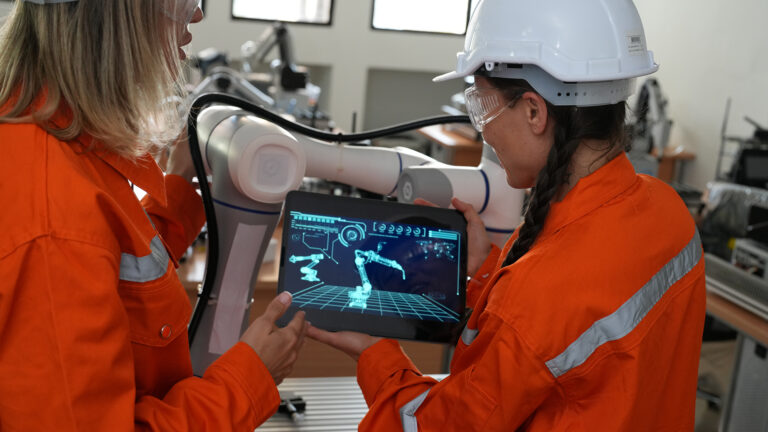In the digital age, technology is advancing by leaps and bounds, and one of the most exciting innovations is the introduction of virtual reality (VR) and augmented reality (AR) headsets. These devices have not only changed the way we entertain ourselves, but are also revolutionizing the way businesses and industries operate and even how their employees interact.
In this article, we will explore the benefits of incorporating VR and AR, or a combination of both, in industrial and enterprise environments, and how these technologies can drive efficiency and productivity.
What is virtual reality and augmented reality?
For those unfamiliar with these terms, broadly speaking VR creates a completely new and immersive environment, while AR overlays virtual elements with the physical world. These technologies offer unique and valuable experiences, and their application in business is becoming increasingly relevant.
A sign of this in recent years are the commercial launches of the Meta Quest and, recently, Apple Vision headsets. Both combine the two technologies to provide an immersive sensation, but without losing sight of the real world around us.
Much more than a game
When many people think of virtual or augmented reality headsets, the first image that comes to mind is that of exciting games and immersive experiences. However, the potential of these devices goes far beyond entertainment.
In business environments, its applications are so varied that they even reach mental health initiatives for employees. Among others, VR helmets allow immersion in realistic simulations of work situations, resulting in more effective and safer training.
1. Training and realistic simulations
One of the main advantages of VR in the business environment is its ability to provide hands-on training without risk. For example, in the manufacturing industry, employees can practice operating complex machinery in a virtual environment before facing real-life situations.
In the agricultural sector, the use of immersive technologieshas been documented for training on livestock and large animal management, biosecurity, disease identification (with AR), among others.
Another case is in healthcare, where performing certain procedures without the appropriate expertise can be risky. In particular, AR can be combined with mannequins equipped with sensors to perform certain maneuvers (such as those related to childbirth or intubation). The helmet allows 3D visualization of the dimensions of the internal anatomy, which serves as a guide for doctors and future professionals.
The use of helmets perfectly complements this type of skills, as it allows students to be introduced to the procedures from a theoretical point of view, then face the mannequins as a second stage and, finally, the patients. This process provides a transition from theory to practice that is more appropriate, quicker and results in fewer errors.
This technology reduces the risk of accidents and accelerates the learning process.
2. Remote collaboration with augmented reality
On the other hand, AR excels in real-time collaboration. Imagine being able to work on a project together with colleagues in different geographic locations, all observing the same virtual object superimposed on their real environments.
Another example is remote training: let's think of a multinational company that manufactures machinery. One group of specialists can train another located in another country or city, for example, to assemble an engine using holograms of each step, with real-time feedback, while working in their own environments.
3. Process optimization and maintenance
In the industrial sector, RA has proven to be an invaluable tool for process optimization and equipment maintenance.
Similar to the training example, technicians can use AR headsets to view relevant information about a machine while they are repairing it, such as user manuals, performance data and technical diagrams. This streamlines maintenance processes and reduces downtime.
In the event that an expert is needed in another location, he or she can assist the person on site in real time by seeing the same thing (through the helmet), as well as providing audio instructions or making notes on the screen that will be displayed on the viewfinder.
In more corporate environments, the use of collaboration tools (such as Microsoft Teams, Zoom, among others) combined with this type of technology allows for more immersive meetings, avoiding distractions or interruptions.
4. Improved efficiency and error reduction
Both VR and AR have the potential to improve operational efficiency by reducing human error. By providing workers with accurate information and detailed visualizations in real time, the possibility of misunderstandings is minimized, improving decision making and eliminating downtime due to relocations (for example).
It also facilitates access to remote diagnostics on machine status and enables precise troubleshooting instructions.
A transformed business future
The application of VR and AR technologies is accelerating digital transformation by streamlining the way businesses and industries operate and make decisions.
The use cases are still growing, and the possibilities are almost endless. From secure training to remote collaboration and process optimization, these technologies offer several benefits, so incorporating them quickly has become a necessity to stay competitive in the marketplace.
For its successful implementation, companies and industries will have to adapt their infrastructure (e.g., connection capacity) and train their human capital.
As we continue to move into a digital future, it pays to keep an eye on the opportunities VR and AR offer and how they can help the industry each of us is immersed in. The future is already here!
Mauricio Pargman, Sales Manager.
Mauricio is a Telecommunications Engineer from Universidad Católica. He has more than 20 years of experience in developing sales teams. Between 2009 and 2012 he was one of the people in charge of opening and leading Isbel's office in the Dominican Republic.



